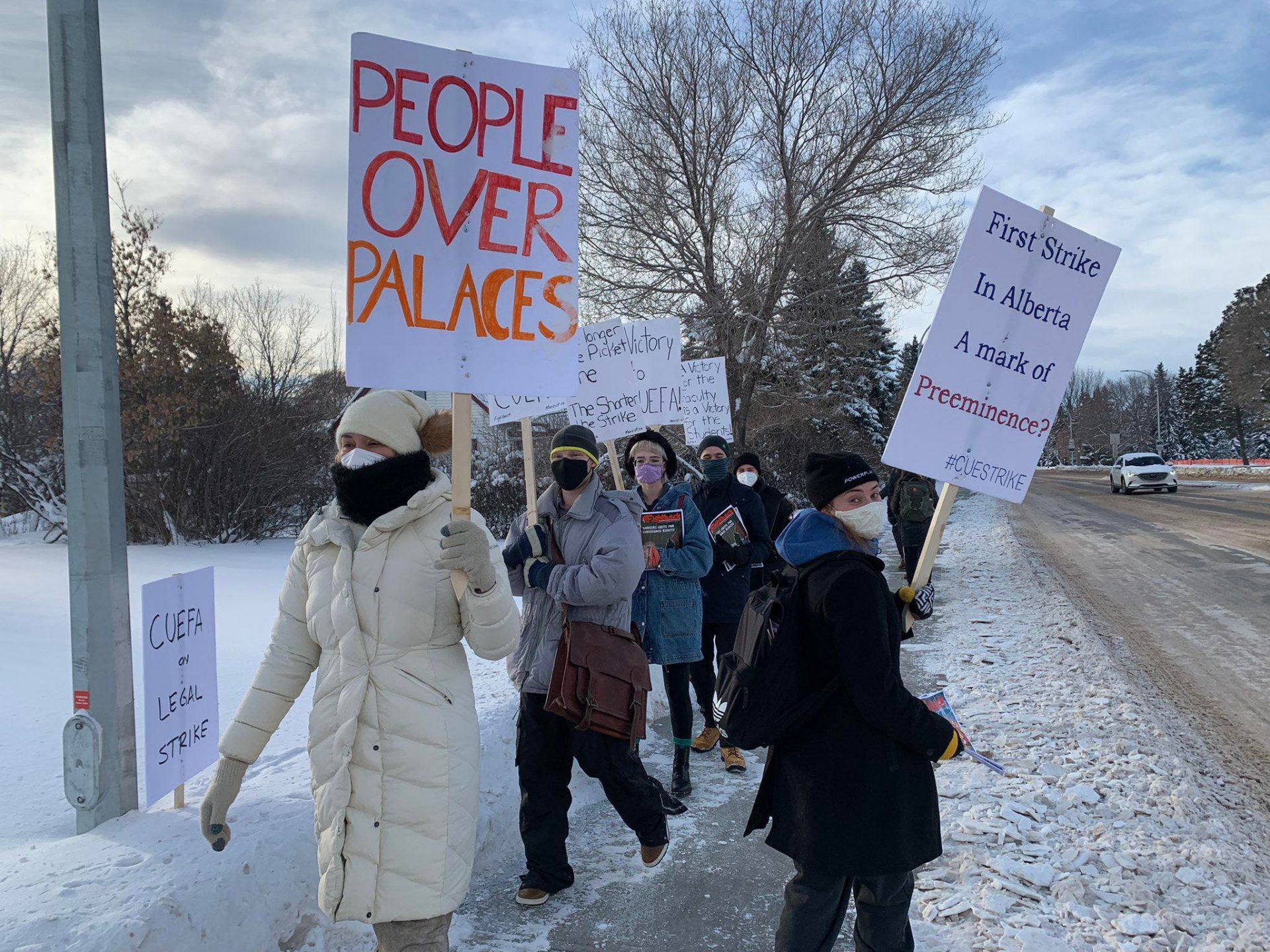
On Jan. 4 in the midst of a brutal Alberta cold snap, the Concordia University of Edmonton faculty walked off the job in a strike. This is the first time in Alberta’s history that a university faculty has gone on strike. Concordia’s faculty association (CUEFA) includes 82 professors, lab instructors, librarians, and placement coordinators. Members of the Alberta Federation of Labour, the Alberta Union of Provincial Employees, Students Supporting the CUEFA, and members of Socialist Fightback have also been on the picket line.
Negotiations between the CUEFA and the Concordia bargaining team had been going on since spring of 2021. The CUEFA voted to support a strike mandate back in November, with a sweeping 90 per cent of members voting in favour, and 95 per cent of members participating in the vote. Then, on Dec. 22, the CUEFA finally issued a legal strike notice. They promised to walk off the job if no agreement was reached by the new year. The bargaining team continued to refuse reasonable salary offers and failed to budge on other key demands.
Concordia’s faculty are among the lowest paid in the entire country, and over the past few years this has caused Concordia to lose professors to better paying jobs at other universities. Now, the faculty are merely asking for salaries in line with those of comparable universities. The last offer made by the administration included no salary increase at all. This is especially insulting given that the administration doesn’t even play by their own rules. The Board of Governors recently made bylaw changes so that President Tim Loreman could have a salary in line with presidents on an agreed upon list of comparator universities.
Another key issue for Concordia’s faculty is the fact that they can currently be dismissed without just cause, meaning they have virtually no job security. And finally, they are facing extreme workloads. While the administration had agreed to reduce the number of classes taught by professors to make up for an increase in research, no agreement was made with regards to librarians, lab instructors, or placement coordinators. Faculty are especially concerned about the workload for these positions. Bad working conditions lead to bad teaching conditions, because if professors and other staff are overburdened, they will not have time to give students the help and resources they need.
Students understand this too. Ashley Callahan, a Concordia student who organized the Students Supporting the CUEFA, says that “what’s happening to faculty is a representation of what will happen to everyone in the work field.” Students will benefit from a successful faculty strike, because it will help to set the precedent for better working conditions once they graduate. Callahan also states that most students support the strike. There were students present at the picket lines, and an online petition circulating in support of the strike has garnered 238 signatures. This represents about 10 per cent of Concordia students, which is very significant considering that there are currently no in-person classes.
However, President Loreman wants us to believe that the strike is very bad for students. He says the strike could threaten the semester, and that it is regrettable. But if the Concordia administration really cared about students’ education, they’d simply meet the demands of the workers. It is the administration who refused their workers’ demands and made a strike inevitable in the first place, and it is also the administration who decided to immediately shut down classes and told sessionals they wouldn’t be paid, even though they are not in the bargaining unit.
And of course, the faculty are striking because they care about their students’ education, not because they want to delay the term. CUEFA President Glynis Price explains, their demands “are about delivering high quality education and research and preserving the tight knit community the administration claims to value but that the instructional staff actually deliver.” It’s obvious that Loreman, and other administrators who have feigned worry for the students, are just trying to sow divisions between students and workers to weaken the strike.
It’s even harder to believe that the administration really cares about students’ education when they recently spent 1.75 million dollars on Magrath Mansion, a building with no discernible use to anyone. Price mentions that you can’t even wear your shoes inside of it. As some workers wrote on their picket signs, “It’s too bad a mansion can’t teach.”
But even if the Concordia administration hadn’t purchased this mansion, they would still be perfectly capable of meeting the demands of their instructional staff. They posted a $7.8-million surplus in 2019-2020 and an $11.5-million surplus in 2020-21, and have not faced any of the UCP’s budget cuts since they are a private university.
Without workers—professors, lab instructors, librarians, and so on—those surpluses would be impossible and Concordia would be nothing but an empty building. In order to ensure the victory of the strike, the CUEFA leadership must keep the campus shut down and work with the student group to increase support. It is also up to the rest of the labour movement to step in and support the strike.
As vicious austerity hits university after university, threatening the education of students and the livelihoods of workers, post-secondary education in Alberta is shaping up to be a hotbed of class struggle. Faculty associations at The University of Lethbridge and Mount Royal University are both in formal mediation, a process which will allow them to legally strike. The administration at Athabasca University is begging for a strike by failing to even table a full offer after nine months of negotiation with the faculty association. The Non-Academic Staff Association at the University of Alberta is also currently bargaining with administration. A victory for the CUEFA would set the tone for the struggle at these universities, as well as the labour movement as a whole.

